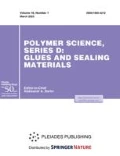Abstract
A classification of naturelike materials and structures used in mechanical engineering is proposed. Naturelike structures, in accordance with the principle of shaping, are subdivided into mesh, honeycomb, and folded. Materials are classified in terms of the type of active component, according to which they are divided into five groups: gradient, encapsulated, gas-filled, containing a liquid matrix, and containing a biologically active component. For each group of naturelike structures and materials, the stages of life cycles are identified at which their naturelike effect is manifested.


Similar content being viewed by others
REFERENCES
A. Guillot and J.-A. Meyer, La Bionique: Quand la Science Imite la Nature (Dunod, 2008).
V. V. Vasil’ev and A. F. Razin, “Prospects for the use of mesh composite structures in civil aviation,” Polet, Nos. 11–12, 3–12 (2016).
E. A. Kosenko, N. I. Baurova, and V. A. Zorin, “The development of natural-like polymer composite materials with liquid matrix and their use in mechanical engineering,” Polym. Sci., Ser. D 13, 341–344 (2020).
E. A. Kosenko, N. I. Baurova, and V. A. Zorin, Nature-Like Materials and Structures in Mechanical Engineering (MADI, Moscow, 2020).
K. I. Donetskii and A. V. Khrul’kov, “Principles of 'green chemistry' in advanced technologies for manufacturing products from PCM,” Aviats. Mater. Tekhnol., No. S2, 24–28 (2014).
M. V. Koval’chuk, “The First Russian Crystallographic Congress: From convergence of sciences to nature-like technologies,” Kristallografiya 63 (2), 173–175 (2018).
Production of Three-Layer Panels with Folded Fillers from Polymer Paper, Ed. by I. M. Zakirov (Fen, Kazan, 2009) [in Russian].
Seventieth Session of the UN General Assembly. http://www.kremlin.ru/events/president/news/50385. Accessed November 26, 2019.
Forum of Convergent and Nature-Like Technologies. http://www.ras.ru/news/shownews.aspx?id=4657199b-367a-4eae-98be-5f95a684ba6f. Accessed November 26, 2019.
M. V. Koval’chuk and O. S. Naraikin, “Nature-like technologies: New opportunities and new threats,” Indeks Bezop. 22 (3–4), 103–108 (2016).
A. A. Berlin, “Fatigue strength of natural materials,” Polym. Sci., Ser. D 13, 57 (2020).
Funding
This work was carried out within the framework of scientific research under project no. 2019-1342.
Author information
Authors and Affiliations
Corresponding author
Ethics declarations
The authors declare that they have no conflict of interest.
Additional information
Translated by K. Lazarev
Rights and permissions
About this article
Cite this article
Kosenko, E.A., Baurova, N.I. & Zorin, V.A. Naturelike Materials and Structures in Mechanical Engineering. Polym. Sci. Ser. D 14, 69–72 (2021). https://doi.org/10.1134/S1995421221010135
Received:
Revised:
Accepted:
Published:
Issue Date:
DOI: https://doi.org/10.1134/S1995421221010135




